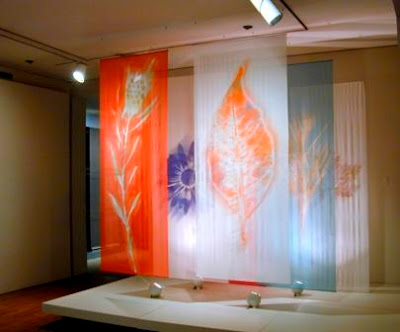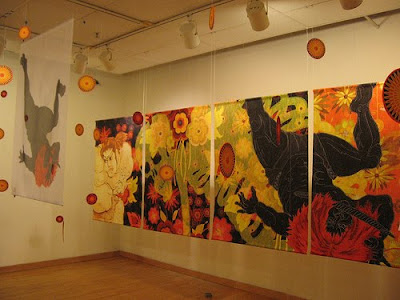
For this final project, I found it really hard to find any inspiration from specific artists. I was originally influenced by Sally Mann’s work on her Deep South series of photographs that she took down in Louisiana and Mississippi, but I wasn’t sure of another artist that inspired me. Mann’s photos were one of the main things that I was interested in exploring further, simply because her “deep south” is almost like the deep south here, where there’s still a lot of negative, war history. Although I found her work to be inspirational, I wanted to find another artist whose work was related to my own. I found that there wasn’t just one artist that I found interesting, but many. The first artist that I came across was Heather Ujiie and her work “Ninja Warrior Face-off.” This work was a series of large digital prints that were on hung pieces of fabric. Her imagery that is used within her piece is influenced by a source far from my own, Kung foo movies and comics. Although the subject matter isn’t the same, the process was for me. I really liked how each of her prints covered the entire piece of fabric and allowed for a full bleed of the work. Also, I was inspired by the type of fabric that she uses, which is a very see-through, flimsy type fabric. It seems to resemble a sort of linen or mesh type material, but I couldn’t find out specifically what she used. Regardless, I found it to be really unique. You could see the images that were hung behind her prints through the prints in front, making each layer or section of work connect to one another. This is something I wanted to do with my artwork, have the fabric be sheer enough so the images outside could be seen on the inside, through the fabric. With this particular work, she actually embroiders the image with thread after she digitally prints it onto the fabric. Her method of stitching is far from what inspired me, but I really enjoyed how it added a handmade quality to each of the large hangings.
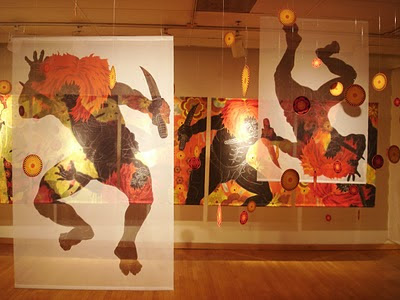
Another artist that I came across was Bonnie Lane. This artist has specific works that also involve digital prints on fabric. Once again, I wasn’t so much interested in her content but more in her process. Her work entitled Every Time You Sleep You Leave Me was a large digitally printed photo on sheer cloth of a sleeping person’s face. Her work also has a sound component of a person breathing while they sleep. Although she has a blue light cast upon the print from afar, her printing technique is very interesting. Like Ujiie’s work, she has printed full-scale photos onto the fabric and hung them in a setting where light can come through the print. Even though her light is artificial the concept still remains the same. Her work Are You Awake? also has large scaled prints but this time with actual text showing through the fabric with colorful lights. One thing that I really like about her work is the artificial light. I was most interested in natural light and how that plays a part into seeing the print like you would in the outside world. Though I think that the aura that colorful artificial light casts through certain materials is beautiful. It really creates a unique glow, especially with black text in front of it. I think that for any of my future project’s I could possibly project text through pieces of fabric with colored light to create this two-toned look. One quote from her that I found particularly interesting was My work is all about showing what I have experienced or known personally but I aim for the audience to be able to relate to it on their own level and somehow put a bit of themselves into the work and create their own story.” This is really how I felt about my work this time around. I knew that a lot of people didn’t know much about Point Lookout but I wanted them to have just enough history to make their own stories up within the context of the negative history that’s occurred there. Regardless of whether or not they’ve experienced it personally themselves, I think that my audience should be able to relate to it through the experience that they have when looking at my prints.
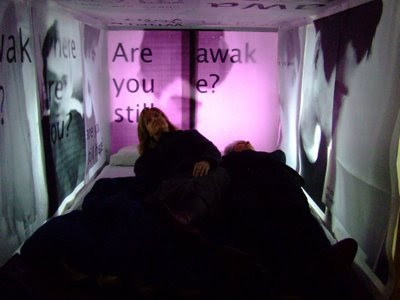
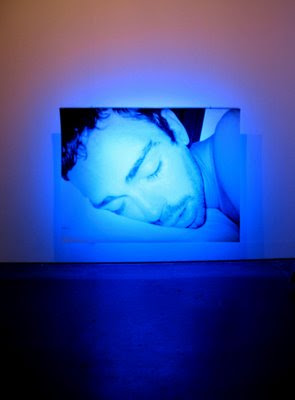
Although I didn’t really find one specific artist whose work was similar to my idea, I found a lot of artists who were all incorporating parts of my idea. I’m really glad that I got the chance to experience other artist’s work before actually creating my own so I had a clear idea of what would look unique and what wouldn’t. I found that using embroidery isn’t always the best option, especially on digitally printed fabric. I also found that projecting certain light through certain fabrics could create effects that no natural light could ever produce. Lastly, the aesthetic of each print was something that I found interesting within both artists. Each artist also have an extensive body of work, especially on fabric printing that I found to be really unique. Although most of the work is unlike mine, the colors, shapes and designs of each print are favorably unique.
